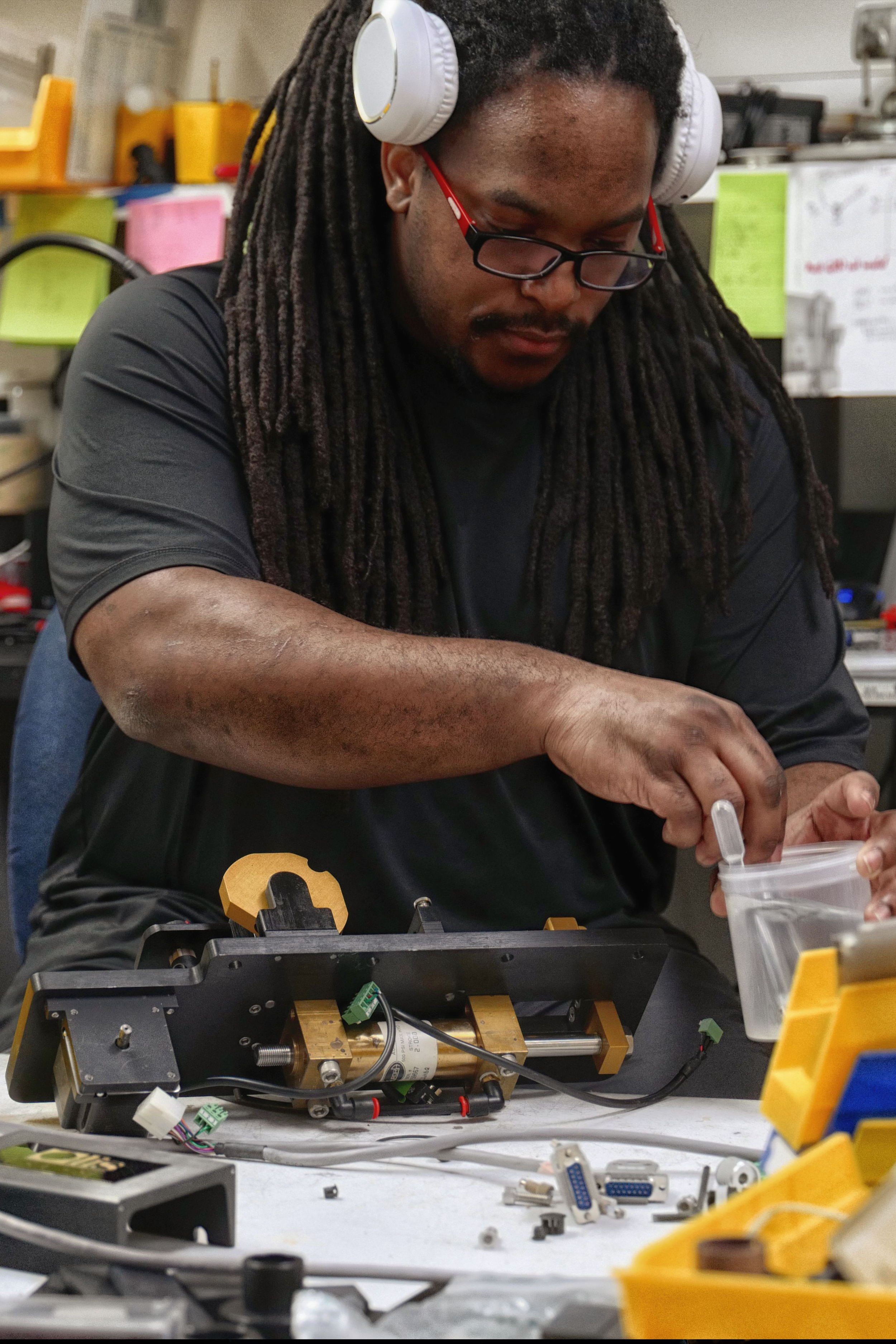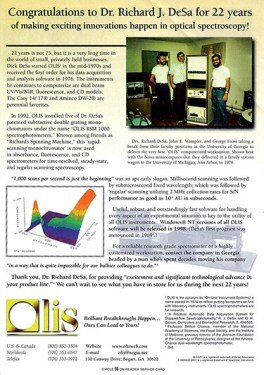An Unbiased View of Circular Dichroism
An Unbiased View of Circular Dichroism
Blog Article
Little Known Facts About Circular Dichroism.
Table of ContentsThe Definitive Guide for Uv/visSome Known Factual Statements About Uv/vis/nir The smart Trick of Uv/vis/nir That Nobody is Talking AboutCircular Dichroism for BeginnersSome Known Facts About Uv/vis/nir.Little Known Questions About Spectrophotometers.The Facts About Uv/vis RevealedIndicators on Uv/vis/nir You Should KnowThe Ultimate Guide To Circular DichroismUv/vis Fundamentals ExplainedSome Of Circularly Polarized LuminescenceWhat Does Uv/vis Do?Unknown Facts About Spectrophotometers
It is then scanned through the sample and the recommendation services. Fractions of the incident wavelengths are sent through, or reflected from, the sample and the recommendation. The resultant light strikes the photodetector device, which compares the relative strength of the 2 beams. Electronic circuits convert the relative currents into direct transmission percentages and/or absorbance/concentration worths.The transmission of a referral compound is set as a baseline (datum) worth, so the transmission of all other substances are recorded relative to the preliminary "zeroed" substance. The spectrophotometer then transforms the transmission ratio into 'absorbency', the concentration of specific parts of the test sample relative to the initial compound.
Considering that samples in these applications are not readily available in big amounts, they are particularly matched to being evaluated in this non-destructive technique. In addition, valuable sample can be conserved by using a micro-volume platform where as little as 1u, L of sample is required for total analyses. A quick explanation of the procedure of spectrophotometry consists of comparing the absorbency of a blank sample that does not contain a colored substance to a sample that includes a colored substance.
Rumored Buzz on Circular Dichroism
In biochemical experiments, a chemical and/or physical home is selected and the procedure that is utilized is particular to that residential or commercial property in order to derive more details about the sample, such as the amount, purity, enzyme activity, etc. Spectrophotometry can be utilized for a number of methods such as identifying optimal wavelength absorbance of samples, determining optimum p, H for absorbance of samples, determining concentrations of unknown samples, and identifying the p, Ka of various samples.: 21119 Spectrophotometry is also a helpful procedure for protein filtration and can also be utilized as a technique to develop optical assays of a substance.
It is possible to know the concentrations of a two element mix utilizing the absorption spectra of the basic options of each element. To do this, it is necessary to understand the extinction coefficient of this mix at 2 wave lengths and the extinction coefficients of services that consist of the recognized weights of the two components.

The 5-Minute Rule for Circularly Polarized Luminescence
A lot of spectrophotometers are used in the UV and visible areas of the spectrum, and some of these instruments likewise run into the near-infrared region also. The concentration of a protein can be approximated by measuring the OD at 280 nm due to the existence of tryptophan, tyrosine and phenylalanine (https://papaly.com/categories/share?id=82b22f606fb5496cbfab4f86fdfbca1c).
This approach needs a spectrophotometer capable of determining in the UV area with quartz cuvettes.: 135 Ultraviolet-visible (UV-vis) spectroscopy involves energy levels that delight electronic transitions. Absorption of UV-vis light thrills molecules that are in ground-states to their excited-states.
20. 8 O.D. Ink producers, printing business, fabrics vendors, and a lot more, require the information offered through colorimetry. They take readings in the region of every 520 nanometers along the noticeable area, and produce a spectral reflectance curve or a data stream for alternative discussions. These curves can be used to test a brand-new batch of colorant to inspect if it makes a match to specifications, e.
Circular Dichroism for Beginners
Traditional noticeable area spectrophotometers can not find if a colorant or the base material has fluorescence. This can make it challenging to handle color issues if for instance several of the printing inks is fluorescent. Where a colorant includes fluorescence, a bi-spectral fluorescent spectrophotometer is used (https://linktr.ee/olisclarity1). There are two major setups for visual spectrum spectrophotometers, d/8 (spherical) and 0/45.
Researchers utilize this instrument to determine the quantity of substances in a sample. In the case of printing measurements two alternative settings are typically utilized- without/with uv filter to manage much better the impact of uv brighteners within the paper stock.
The smart Trick of Uv/vis That Nobody is Discussing
Some applications require little volume measurements which can be carried out with micro-volume platforms. As explained in the applications area, spectrophotometry can be utilized in both qualitative and quantitative analysis of DNA, RNA, and proteins. Qualitative analysis can be utilized and spectrophotometers are used to tape spectra of compounds by scanning broad wavelength regions to identify the absorbance properties (the intensity of the color) of the substance at each wavelength.

Some Known Details About Uv/vis
One major element is the kind of photosensors that are readily available for various spectral regions, but infrared measurement is likewise tough because virtually everything releases IR as thermal radiation, specifically at wavelengths beyond about 5 m. Another problem is that several materials such as glass and plastic soak up infrared, making it incompatible as an optical medium.
Samples for IR spectrophotometry might be smeared in between 2 discs of potassium bromide or ground with potassium bromide and pressed into a pellet. Where liquid solutions are to be determined, insoluble silver chloride is used to construct the cell. Spectroradiometers, which run practically like the visible area spectrophotometers, are created to measure the spectral density of illuminants. 2013. p. 13. Allen, DW; Cooksey, C; Tsai, BK (Nov 13, 2009). "Spectrophotometry". Obtained Dec 23, 2018. Ninfa AJ, Ballou DP, Benore M (2010 ). Fundamental Laboratory Techniques for Biochemistry and Biotechnology (second ed.). Hoboken: Wiley & Sons. ISBN 9780470087664. OCLC 488246403. Schwedt G (1997 ). The important guide to analytical chemistry.
Oke, J. B.; Gunn, J. E.
The Main Principles Of Spectrophotometers

1021/ac50048a728. ISSN0003-2700. Ninfa AJ, Ballou DP, Benore M (2015 ). Fundamental Lab Methods for Biochemistry and Biotechnology (3, rev. ed.). Hoboken, NJ: Wiley & Sons. p. 77. ISBN9780470924525. OCLC915641828. "Completely Automatic Double Beam - Atomic Absorption Spectrophotometer (AA 8000)". Laboratory Devices. Labindia Analytical Instruments Pvt. Ltd. "Spectrophotometry Applications and Basics".
Uv/vis Things To Know Before You Get This
Recovered Jul 4, 2018. Trumbo, Toni A.; Schultz, Emeric; Borland, Michael G.; Pugh, Michael Eugene (April 27, 2013). "Applied Spectrophotometry: Analysis of a Biochemical Mixture". Biochemistry and Molecular Biology Education. 41 (4 ): 24250. doi:10. 1002/bmb. 20694. PMID 23625877. (PDF). www. mt.com. Mettler-Toledo AG, Analytical. 2016. Obtained Dec 23, 2018. Cortez, C.; Szepaniuk, A.; Gomes da Silva, L.
"Checking Out Proteins Filtration Techniques Animations as Tools for the Biochemistry Mentor". Journal of Biochemistry Education. 8 (2 ): 12. doi:. Garrett RH, Grisham CM (2013 ). Biochemistry. Belmont, CA: Cengage. p. 106. ISBN 978-1133106296. OCLC 801650341. Vacation, Ensor Roslyn (May 27, 1936). "Spectrophotometry of proteins". Biochemical Journal. 30 (10 ): 17951803. doi:10. 1042/bj0301795.
PMID 16746224. Hermannsson, Ptur G.; Vannahme, Christoph; Smith, Cameron L. C.; Srensen, Kristian T.; Kristensen, Anders (2015 ). "Refractive index dispersion noticing using a range of photonic crystal resonant reflectors". Applied Physics Letters. 107 (6 ): 061101. Bibcode:2015 Ap, Ph, L. 107f1101H. doi:10. 1063/1. Go Here 4928548. S2CID 62897708. Mavrodineanu R, Schultz JI, Menis O, eds.
Uv/vis/nir Things To Know Before You Get This
U.S. Department of Commerce National Bureau of Standards unique publication; 378. Washington, D.C.: U.S. National Bureau of Standards. p. 2. OCLC 920079.
The procedure begins with a regulated source of light that lights up the analyzed sample. In the case of reflection, as this light interacts with the sample, some is absorbed or released. The produced light journeys to the detector, which is analyzed, measured, and presented as industry-standard color scales and indices.
Industry governing bodies usually define specific metrics for particular items, such as Tomato and Coffee indices. The simplified math looks like this: Where R is the reflection coefficient. All terms are examined over the visible spectrum from 400 to 700 nm. In the case of transmission, when the light interacts with the sample, it is either soaked up, shown, or transferred.
Rumored Buzz on Circularly Polarized Luminescence
Examples consist of APHA (American Public Health Association) for watercolor and purity analysis, ASTM D1500 for petrochemical color analysis, edible oil indices utilized in food, and color analyses of drinks. All terms are assessed over the noticeable spectrum from 400 to 700 nm.
Image Credit: Matej Kastelic/ Dr. Arnold J. Beckman and his coworkers at the National Technologies Laboratories initially created the spectrophotometer in 1940. In 1935 Beckman founded the business, and the discovery of the spectrophotometer was their most ground-breaking innovation. Dr. Bruce Merrifield, a Nobel prize-winning biochemist, mentioned that the development of the spectrophotometer was "probably the most important instrument ever developed towards the development of bioscience." Before the discovery of the spectrophotometer, chemical analyses took weeks to finish, with 25% accuracy.
Fascination About Circular Dichroism
Over time, scientists kept improving the spectrophotometer design to improve its efficiency. The UV capabilities of the model B spectrophotometer were enhanced by replacing the glass prism with a quartz prism.
After 1984, double-beam versions of the device were developed. The addition of external software with the arrangement of onscreen screens of the spectra came in the 1990s. Generally, a spectrophotometer is comprised of two instruments, specifically, a spectrometer and a photometer. A fundamental spectrophotometer contains a light, a monochromator, a collimator for straight light beam transmission, a cuvette to position a sample, and a photoelectric detector.
The 10-Minute Rule for Spectrophotometers
There are various kinds of spectrophotometers in numerous shapes and sizes, each with its own function or functionality. A spectrophotometer figures out how much light is shown by chemical elements. UV/Vis. It measures the difference in light strength based upon the total quantity of light presented to a sample and the quantity of light beam that goes through the sample solution
A spectrophotometer is used to figure out the concentration of both colorless and colored solutes in an option. This instrument is utilized to figure out the rate of a reaction.
Report this page